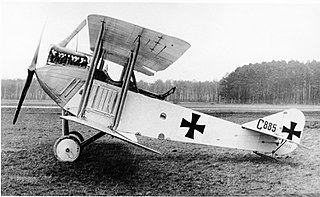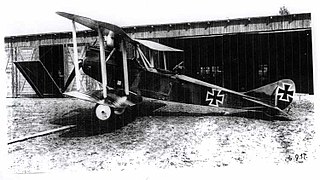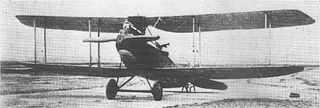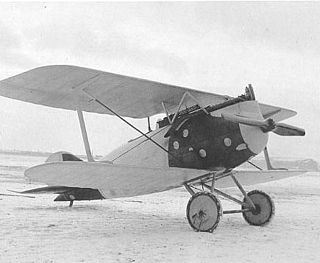
The AEG C.II was a German two-seat biplane reconnaissance aircraft produced in small numbers from October 1915. It was a slightly smaller version of the C.I with better performance, redesigned cockpit for both pilot and observer/bombardier, new rear mounting for a 7.92 mm (.312 in) Parabellum MG14 machine gun, and the ability to carry four 10 kg (22 lb) bombs for light attack duties.

The Albatros C.III was a German two-seat general-purpose biplane of World War I, built by Albatros Flugzeugwerke. The C.III was a refined version of the successful Albatros C.I and was eventually produced in greater numbers than any other C-type Albatros.

The Albatros C.I,, was the first of the successful C-series of two-seat general-purpose biplanes built by Albatros Flugzeugwerke during World War I. Based on the unarmed Albatros B.II, the C.I reversed the pilot and observer seating so that the observer occupied the rear cockpit which was fitted with a ring-mounted 7.92 mm (0.312 in) Parabellum MG14 machine gun.

The Rumpler C.IV was a German single-engine, two-seat reconnaissance biplane. It was a development of C.III with different tail surfaces and using a Mercedes D.IVa engine in place of the C.III's Benz Bz.IV. The Rumpler 6B 2 was a single-seat floatplane fighter variant with a 120 kW (160 hp) Mercedes D.III engine built for the Kaiserliche Marine.

Entering service in 1915, the Rumpler C.I,, two-seater single-engine reconnaissance biplane, was one of the first German C-type aircraft, and also one of the longest serving in its class during World War I, being retired from the last front line units only in early 1918.
Numbers 467 to 470 were four examples of a unique seaplane design produced for the flying service of the Imperial German Navy during the First World War. These four aircraft were the subject of an order by the Navy for trainer seaplanes for the base at Putzig, at a time when most trainers were merely obsolete front-line types.
Imperial German Navy seaplanes numbers 1105 to 1106 were the only two examples of a unique design produced for the navy's flying service during the First World War. They were unarmed biplanes of conventional configuration with staggered wings of unequal span. The empennage included a sizable ventral fin. Intended as training aircraft, the pilot and instructor sat in tandem, open cockpits. The undercarriage consisted of twin pontoons. The interplane strut arrangement was remarkable for its day, consisting of N-struts and V-struts without any rigging wires.

Imperial German Navy seaplanes 463 to 466 were a unique seaplane design produced for the Navy's flying service during the First World War. The seaplane base at Kiel-Holtenau ordered the type as a training aircraft in 1915, and the Navy allocated a batch of four serial numbers to the design. No 463 and its siblings were conventional, two-bay biplanes with unstaggered wings of equal span and two open cockpits in tandem for the pilot and instructor. The undercarriage consisted of twin pontoons. The large, square rudder was hinged to the rear end of the fuselage, and extended below the ventral line of the fuselage. The inline engine was neatly cowled in, with the exhaust being collected together in a single stack that extended above the upper wing.

Imperial German Navy seaplanes 461 and 462 were the only two examples of a seaplane design produced for the Navy's flying service during the First World War. Number 461 was built in October 1916 and Number 462 in September 1917 as the German seaplane bases searched for purpose-built training aircraft to supplement their collection of retired combat types.
Imperial German Navy seaplane Number 945 was the sole example of a unique seaplane design produced during the First World War. Throughout the war, the Kaiserliche Werft Wilhelmshaven had been producing small numbers of training seaplanes for the German Navy, but as the conflict continued, they built a small number of armed types as well, including Number 945. While the general layout of this aircraft was conventional enough for its day, it included a number of unusual features. The single-bay wings were braced with single, large I-struts, and the vertical stabiliser was virtually non-existent, consisting of little more than a stub on the dorsal side of the rear fuselage. The rudder was hinged to the end of the fuselage and hung down below it. The Navy classified it as a C3MG type; indicating armament with both fixed and trainable machine guns.
Imperial German Navy seaplane number 947 was a reconnaissance aircraft produced during the First World War, the sole example of its type. It was one of only three armed aircraft built by the Kaiserliche Werft Wilhelmshaven amongst a variety of trainer seaplanes that they had produced for the Navy during the course of the war. Number 947 was a two-bay biplane of conventional design, with twin pontoon undercarriage, and two open cockpits in tandem. It received the Naval classification CHFT, indicating an armed aircraft equipped with radio gear capable of both sending and receiving.

The Rumpler C.III was a biplane military reconnaissance aircraft built in Germany during World War I.

The Rumpler C.VII was a military reconnaissance aircraft built in Germany during World War I. It was developed from the C.IV and optimised for high-altitude missions that would allow it to operate at heights that would render it immune to interception by enemy fighters. Work on the C.VII took place after a similar attempt to develop the C.III into a high-altitude machine as the C.V failed.

The Rumpler D.I was a fighter-reconnaissance aircraft produced in Germany at the end of World War I. It was a conventional single-bay biplane with wings of unequal span braced by I-struts. It featured an open cockpit and a fixed, tailskid undercarriage. The upper wing was fitted with aerodynamically balanced ailerons and fuselage had an oval cross-section.

The Rumpler G.I was a bomber aircraft produced in Germany during World War I, together with refined versions known as the G.II and G.III.
The Sablatnig SF-1 was a reconnaissance seaplane built in Germany during the First World War.
The Sablatnig SF-2 was a reconnaissance seaplane produced in Germany during the First World War.
The Sablatnig SF-5 was a reconnaissance seaplane produced in Germany during the First World War.

The Sablatnig SF-8 was a training seaplane produced in Germany during the First World War. While Sablatnig's previous designs for the Imperial German Navy had often seen service as trainers, the SF-8 was purpose-built for this role, at Dr Sablatnig's suggestion. The SF-8 was similar to the firm's earlier designs: a conventional two-bay biplane with staggered wings of unequal span, with open cockpits in tandem.
The Siemens-Schuckert R.III was a prototype bomber aircraft built in Germany during World War I. It was one of six aircraft based on the Siemens-Schuckert R.I that were originally intended to be identical, but which each developed in a different direction and were designated as different aircraft types by the German Inspectorate of Flying Troops. The aircraft's development was impeded by the unreliability of its Maybach HS engines, and when it was eventually accepted for military service, it was only in a training role.












